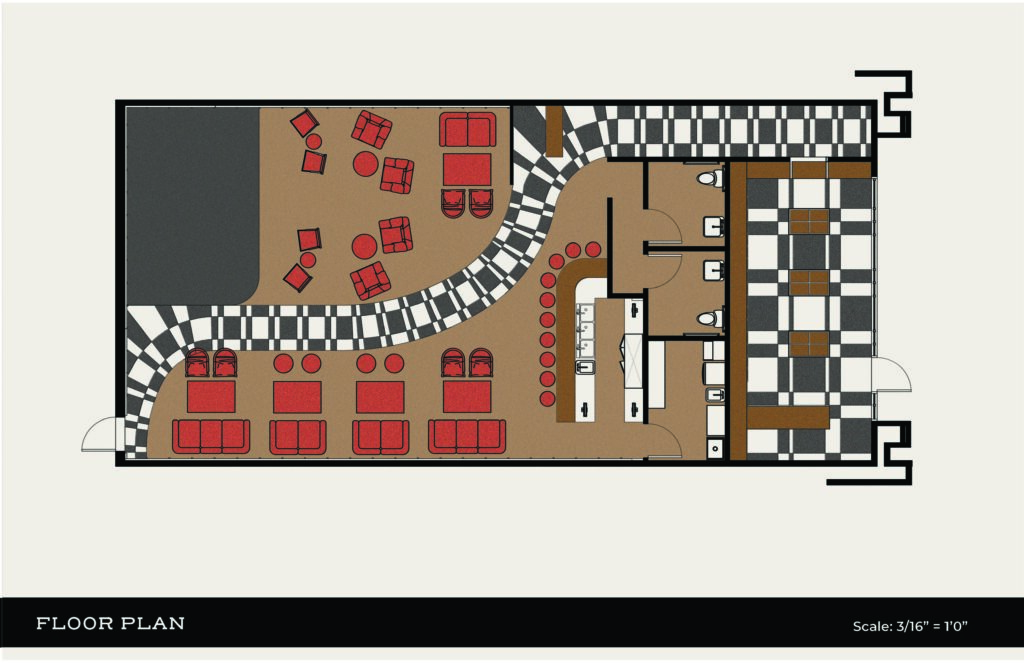BFA in Interior Design

Students interested in studying Interior Design sign up for the Interior Design Pre-Major. A portfolio examination is held at the end of the first year in the program. Successful passage of the review is required in order to declare the Interior Design major and move forward to second year courses. The Interior Design major is a 4-year lock-step program.
The Bachelor of Fine Arts in interior design requires 68 semester hours in interior design courses, including:
- A first-year portfolio examination that is required before advancing to the second-year major courses.
- 39 semester hours taken at the upper level.
- A summer interior design internship between the junior and senior years.
See the course catalog for a complete list of course offerings and descriptions.
TCU interior design majors learn how to shape our environments — where we live and work. Through interior design theory and practical, hands-on projects, you’ll develop the creativity, knowledge and design skills to envision and construct great spaces. At TCU, our faculty composed of industry professionals teach you principles and elements of design, drafting techniques, concept development, computer modeling, space planning, lighting and visual presentation skills.
Studying interior design is an exciting blend of creativity and practical skills, offering the opportunity to shape environments and improve lives. From unleashing artistic expression to mastering versatile skills in design, communication, and project management, students gain a unique set of abilities. Interior design goes beyond aesthetics, emphasizing the impact on well-being and sustainability. With a thriving industry and global perspectives, this field opens doors to diverse career opportunities, making it a compelling choice for those passionate about creating meaningful spaces.



What Does an Interior Designer Do?


At TCU, you’ll learn by doing, stepping outside the classroom to turn your ideas into action. All interior design students complete an internship between the third and fourth year in the program, and many are hired at the companies where they interned.
Examples of internship placements for interior design students include:
- Gensler
- HKS Architects
- Corgan
- Wilson & Associates
- Perkins & Will
- HOK
- IA Interior Architects
- Stantec
- Cannon Design
- SmithGroup
- DLR Group
- Callison RTKL
- STUDIOS Architecture
- Skidmore, Owings & Merrill
- Rockwell Group
- Leo A Daly
From understanding the principles of lighting and indoor air quality to working in teams and communicating your design ideas effectively, you’ll be prepared for successful careers in manufacturing, furniture production, design showrooms, retailing, real estate and facilities management.
Interior Design State Regulation
In the United States, regulation of Professional Interior Design Practice varies by state. ASID, the American Society of Interior Designers has prepared a comprehensive map outlining Interior Design Registration Laws by state:
https://www.asid.org/advocate-by-design/state-policy
Advocate by Design – State Policy
www.asid.org
The American Society of Interior Designers (ASID) advances the interior design profession and communicates the impact of design on the human experience.
Academic Accreditation – CIDA – Council for Interior Design Accreditation
The recognized North American accrediting body for Interior Design programs is CIDA. TCU’s program has been continuously accredited by CIDA (formerly FIDER – Foundation for Interior Design Education and Research) since 1978.
Professional Examination – NCDIQ – National Council for Interior Design Qualification
Interior Design graduates may apply to take the NCIDQ (National Council for Interior Design Qualification) exam through the pathway for CIDA-accredited programs as outlined in NCIDQ’s “Examination Eligibility Paths” https://www.cidq.org/paths. Due to CIDA accreditation, TCU’s Interior Design program meets the educational requirements to apply to sit for the NCDIQ exam. In addition to graduation from a CIDA-accredited program, the application for the exam specifies minimum number of hours of verified work experience under a direct supervisor and/or sponsor as defined in the CIDQ paths link. For states where Interior Design is a regulated profession, passage of the NCIDQ exam is required for licensure or certification. Some states have additional requirements.
CIDQ Credentialing Information
https://www.cidq.org/credentials
CIDA PROFESSIONAL STANDARDS
The Professional Standards set forth by the Council for Interior Design Accreditation are used to evaluate interior design programs that prepare students for entry-level interior design practice and position them for future professional growth. CIDA is firmly committed to setting high standards for interior design education, challenging others to meet and exceed those standards, and seeking ways to continuously elevate and evolve the standards, thus significantly contributing to the advanced professionalism of the interior design field.
Accreditation
The TCU interior design program is accredited by The Council for Interior Design Accreditation. CIDA has continuously accredited the curriculum since 1978. The CIDA-accredited program prepares students for the opportunity to complete the necessary steps to obtain state licensing or registration. This major is for the student planning a career as a licensed or registered designer with interior design and/or architectural firms.
The interior design program leading to the Bachelor of Fine Arts degree in Interior Design is accredited by the Council for Interior Design Accreditation, www.accredit-id.org, 206 Grandville Avenue, Suite 350, Grand Rapids, MI, 49503.
The CIDA-accredited program prepares students for entry-level interior design practice, for advanced study, and to apply for membership in professional interior design organizations. The BFA in Interior Design granted by Texas Christian University meets the educational requirement for eligibility to sit for the National Council for Interior Design Qualification Examination (NCIDQ Exam). For more information about NCIDQ Exam eligibility visit: https://www.cidq.org/eligibility-requirements.
2023 CIDA TCU Student Achievement Data
Student Achievement Data
Texas Christian University, Interior Design Program, B.F.A. in Interior Design
It typically takes a full-time student taking approximately 15 credits per semester four years to complete the degree program.
The following data was collected using institutional records and correspondence with alumni upon graduation of the Spring 2023 class.
Student Attrition and Retention
97% of students admitted through the annual portfolio examination process in May 2022 returned in the fall of 2022, putting attrition at 3%.
Graduation Rates:
Of the students graduating in 2023, 100% graduated in 4 years from the Interior Design Program.
Acceptance into Graduate Programs:
7% of students who graduated in May 2023 will attend graduate school starting Fall 2023.
Job Placement Rates:
As of May 2023, 87% of students who graduated in May 2022 are employed in interior design or a related profession.
Transfer Policy
After they have been accepted to the University, students wishing to transfer credits from another Interior Design program to TCU’s Interior Design program must submit a comprehensive portfolio including all syllabi, project/assignment descriptions from their previous institution, and studio project work to the attention of the Interior Design Program Coordinator. Once the materials are provided to the department they will be reviewed and assessed by interior design faculty. All transfer decisions are final.
Laptop Policy
Upon successful passage of the portfolio examination, students are required to purchase a PC laptop based upon specifications which are updated annually. A computer is not required for the first year in the program. Refer to the posted laptop policy. This policy will be updated annually in late spring with detailed system specifications, software requirements and program policies. Enrolled students are required to have a PC laptop computer and legally licensed CAD, 3D modeling, presentation and productivity software for use in their interior design courses.
The TCU interior design program does not endorse any particular computer manufacturer, brand or vendor. The specifications for interior design emphasize performance over any particular brand, but it must be a PC computer. Interior design courses will teach the software programs from the Microsoft Windows platform. Students will be responsible for resolving their own laptop technical issues.
